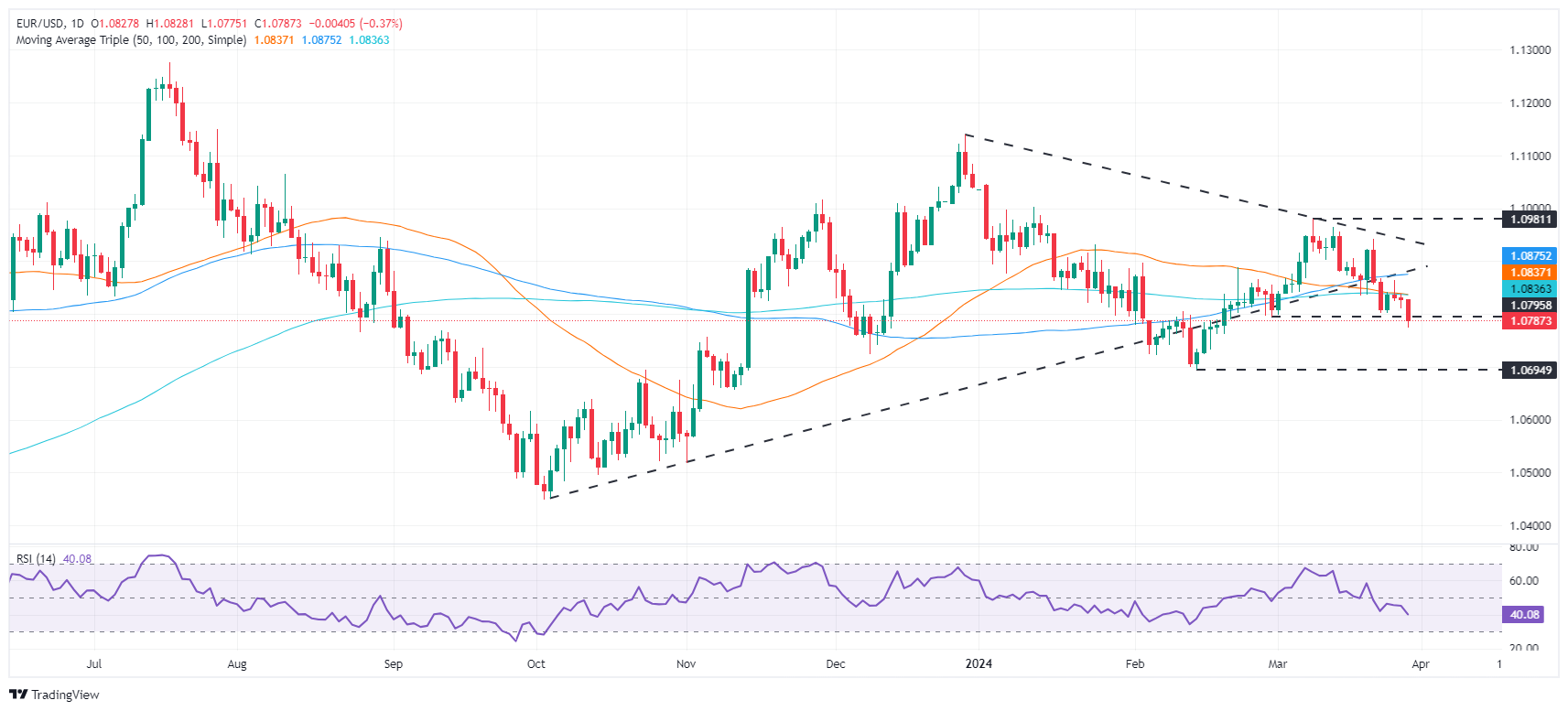- EUR/USD faces downward pressure after ECB’s Villeroy highlights the necessity of rate cuts to achieve inflation targets.
- Strong US economic performance, highlighted by revised GDP growth and sustained labor market tightness, supports the Dollar.
- Market anticipation grows for the upcoming US Core PCE price index, with potential implications for Fed’s monetary policy.
The Euro extends its losses against the US Dollar, with the major diving below the 1.0800 figure, following dovish comments by European Central Bank (ECB) policymaker Francois Villeroy. The EUR/USD trades at 1.0787, down 0.37%.
EUR/USD fails pressured by ECB’s rate cut hints
ECB’s Villeroy comments increased EUR/USD sellers’ momentum late in the North American session. He said that core inflation decline is rapid but still high. He added that the 2% ECB inflation goal is within reach, while he saw increasing downside risks if the ECB didn’t cut rates. On the data front in the Eurozone, German Retail Sales plunged below estimates.
Recent data from the United States (US) showed the economy remains resilient after the Gross Domestic Product (GDP) for Q4 2023 was revised from 3.2% to 3.4%. Other data showed that the number of Americans filing for unemployment benefits was below estimates, and the previous week’s data, for the fourth consecutive week, an indication of the tightness of the labor market.
Further data revealed that the University of Michigan Consumer Sentiment hit its highest level since 2021, coming at 79.4, above the preliminary estimate of 76.5. Meanwhile, Pending Home Sales were up 1.6% Month over Month in February, beating expectations.
Given the backdrop, along with hawkish comments by Federal Reserve Governor Christopher Waller, were the drivers behind US Dollar bulls, which stepped in ahead of the release of the US Core Personal Consumption Expenditures (PCE) price index data.
EUR/USD Price Analysis: Technical outlook
After diving below the 200-day moving average (DMA), the EUR/USD has resumed to the downside, breaching below the February 29 cycle low of 1.0794 and sliding towards the 1.0780 area. If the pairs post a daily close below 1.0800, that will exacerbate the challenge of the February 14 low of 1.0694, ahead of 1.0600.
In another scenario, if EUR/USD buyers lift the pair above 1.0800, that could pave the way to test the 200-DMA at 1.0835.

Euro FAQs
The Euro is the currency for the 20 European Union countries that belong to the Eurozone. It is the second most heavily traded currency in the world behind the US Dollar. In 2022, it accounted for 31% of all foreign exchange transactions, with an average daily turnover of over $2.2 trillion a day. EUR/USD is the most heavily traded currency pair in the world, accounting for an estimated 30% off all transactions, followed by EUR/JPY (4%), EUR/GBP (3%) and EUR/AUD (2%).
The European Central Bank (ECB) in Frankfurt, Germany, is the reserve bank for the Eurozone. The ECB sets interest rates and manages monetary policy. The ECB’s primary mandate is to maintain price stability, which means either controlling inflation or stimulating growth. Its primary tool is the raising or lowering of interest rates. Relatively high interest rates – or the expectation of higher rates – will usually benefit the Euro and vice versa. The ECB Governing Council makes monetary policy decisions at meetings held eight times a year. Decisions are made by heads of the Eurozone national banks and six permanent members, including the President of the ECB, Christine Lagarde.
Eurozone inflation data, measured by the Harmonized Index of Consumer Prices (HICP), is an important econometric for the Euro. If inflation rises more than expected, especially if above the ECB’s 2% target, it obliges the ECB to raise interest rates to bring it back under control. Relatively high interest rates compared to its counterparts will usually benefit the Euro, as it makes the region more attractive as a place for global investors to park their money.
Data releases gauge the health of the economy and can impact on the Euro. Indicators such as GDP, Manufacturing and Services PMIs, employment, and consumer sentiment surveys can all influence the direction of the single currency. A strong economy is good for the Euro. Not only does it attract more foreign investment but it may encourage the ECB to put up interest rates, which will directly strengthen the Euro. Otherwise, if economic data is weak, the Euro is likely to fall. Economic data for the four largest economies in the euro area (Germany, France, Italy and Spain) are especially significant, as they account for 75% of the Eurozone’s economy.
Another significant data release for the Euro is the Trade Balance. This indicator measures the difference between what a country earns from its exports and what it spends on imports over a given period. If a country produces highly sought after exports then its currency will gain in value purely from the extra demand created from foreign buyers seeking to purchase these goods. Therefore, a positive net Trade Balance strengthens a currency and vice versa for a negative balance.

























